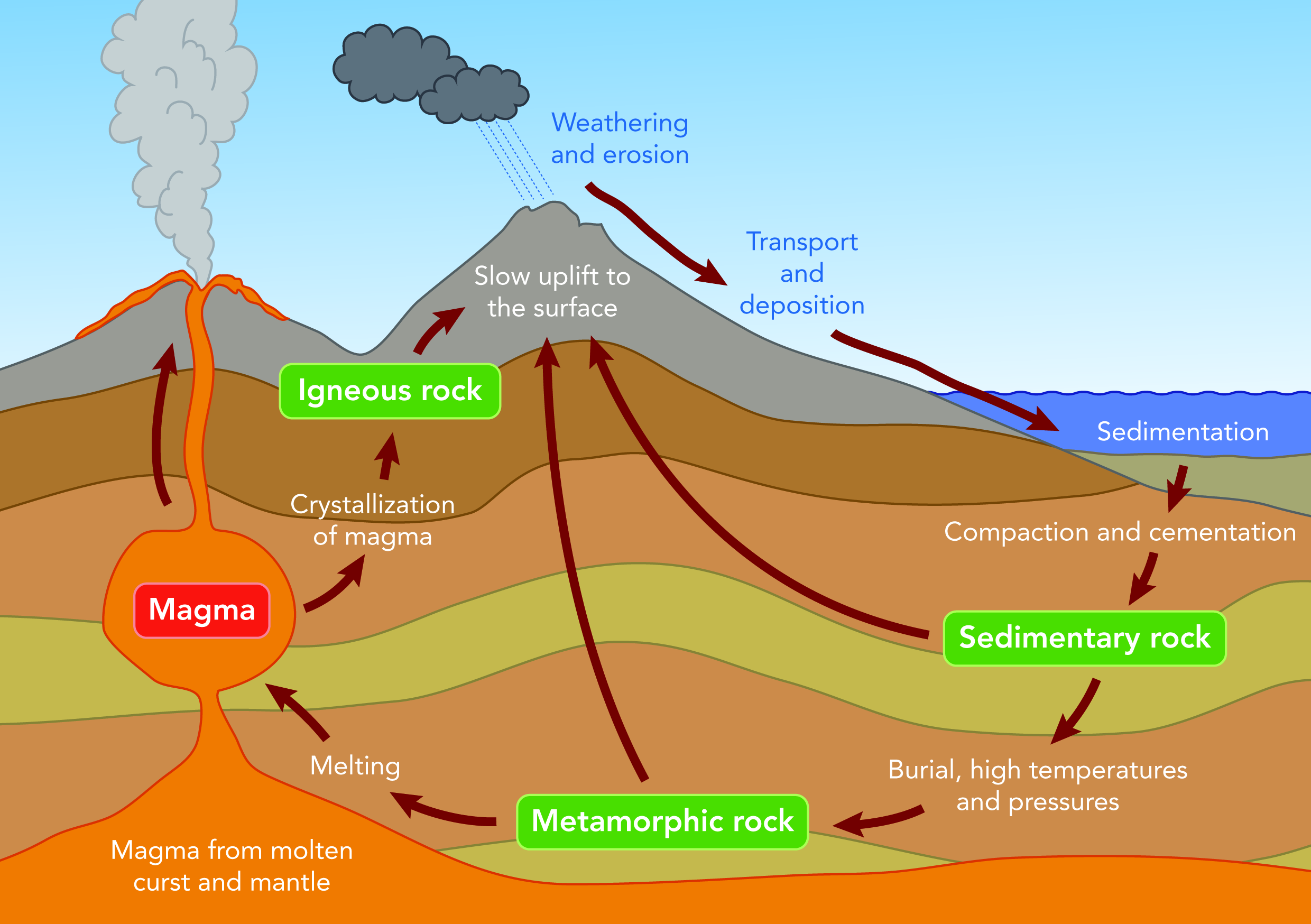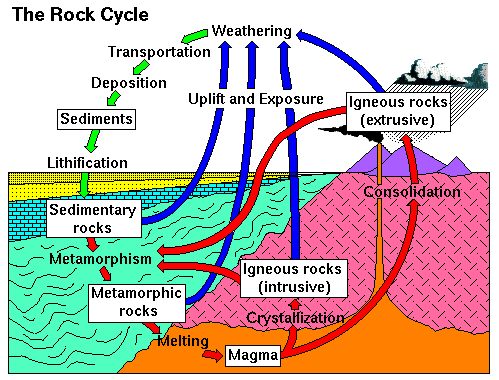Blank Igneous Rocks Form on or Very Near Earth's Surface
What rock can melt and cool to form igneous rock. Fine-grained igneous rocks that cool quickly on Earths surface.

3 5 The Rock Cycle Physical Geography And Natural Disasters
While molten they flow out onto the surface or flow into cracks near the Earths surface.

. Chapter 3 Igneous Rock Vocabulary. Basaltic lava flows_____ from a volcano. Igneous Rocks are classified using 1.
They cool quickly with no time for large crystals to grow. Due to this quick cooling the minerals in the rock do not have much time to form very large crystals. Learn vocabulary terms and more with flashcards games and other study tools.
Relationships between preexisting rock D. Rare ultramafic rock that can contain diamonds and other minerals formed only under very high pressures. E May be 1 small grained.
The magma called lava when molten rock erupts on the surface cools and solidifies almost instantly when it is exposed to the relatively cool temperature of the atmosphere. Weathering and erosion of surface features B. The lava that erupts from the volcano will cool and solidify quickly in the contrasting temperature at the surface of our planet.
Rocks formed below earths surface are intrusive because they are formed inside the earths core. The terminology Igneous means fire or heat. How Extrusive Igneous Rocks are Formed.
Igneous Rocks are formed from D that cools 1. They are thus very fine grained. Extrusive or volcanic igneous rock is produced when magma exits and cools above or very near the Earths surface.
Cooling rate and gas content create a variety of rock textures. Intrusive igneous rocks are formed beneath the earths surface when magma cools and extrusive igneous rocks form when lava extrudes from a volcano and cools. There is little time for crystals to form so extrusive igneous rocks have tiny crystalsCooling rate and gas content create a variety of rock textures.
They are simply the rocks formed through heating then followed by cooling. Intrusive or plutonic A type of igneous rock that forms inside the Earth. Basaltic rocks contain _____and_____ but very little silica.
2 See answers Advertisement Advertisement gfranco6991 gfranco6991 Answer. All magma develops underground in the lower crust or upper mantle because of the intense heat there. Igneous rocks are called extrusive when they cool and solidify above the surface.
A type of igneous rock that forms above Earths surface. Rocks form when cools below Earths surface. Magma cooling at or near earths surface forms small grained _____ igneous rock.
Igneous rocks that form below the Earths surface are called intrusive igneous rocks or plutonic. What igneous rocks form on or very near Earths surface. Fill in the blanks to complete each statement about igneous rock formation.
These rocks usually form from a volcano so they are also called volcanic rocks. Igneous rocks can have many different compositions depending on the magma they cool from. Rocks form when cools on Earths surface.
In this sense igneous rocks are formed when molten rock magma solidifies either underneath the earths crust to form plutonic intrusive igneous rocks or on the surface of the earth to form volcanic extrusive igneous rocks. They crystallize when magma enters an underground chamber and cools very slowly. It is a type of igneous rock that forms in very shallow depths ie just below the earths surface.
Igneous rocks that form below the Earths surface are called intrusive igneous rocks. There is little time for crystals to form so extrusive igneous rocks have tiny crystals. Prentice Hall Chemistry Chapter 16 Vocab.
Igneous rocks that are dark colored and dense. Extrusive igneous rocks cool much more rapidly than intrusive rocks. Igneous rocks that form at surface.
These are the rocks that form at erupting volcanoes and oozing fissures. Igneous rocks are called extrusive when they cool and solidify above the surface. F that indicates composition based on J that can be 1 High for example 1 2 K for example Middle to Top.
At earths surface to form A an example of H 2. 32 Igneous rocks form from molten rock. OTHER SETS BY THIS CREATOR.
C to form B an example of I. These rocks usually form from a volcano so they are also called volcanic rocks. Igneous rocks form either when they cool very slowly deep within the Earth intrusive or when magma cools rapidly at the Earths surface extrusive.
Mafic rocks tend to be dark in color due to the presence of large amounts of iron and magnesium. 5 Igneous rocks Earth Science. They form when magma enters an underground chamber cools very slowly and forms rocks full of large crystals.
The rapid cooling of the extrusive igneous rock happens on the surface or very near the surface of the earth. A useful tool illustrating the relationships among igneous sedimentary and metamorphic rocks is called the ___. Igneous rocks form when magma molten rock cools and crystallizes either at volcanoes on the surface of the Earth or while the melted rock is still inside the crust.
These rocks are in many ways similar to other intrusive rocks but have intermediate grain sizes and textures generally half way between those found in extrusive and other types of intrusive rocks. Plate tectonic cycle C. Therefore they are very dark and are very rare at the surface of the Earth.
Mineral composition can only be identified with a microscope unless phenocrysts are present. Rock may melt to create magma if temperature increases pressure decreases or water is. The heated material is the molten.
For example I 2. Igneous rocks are divided into two groups based on where the rock forms. Do igneous rocks only form.
Igneous rocks derived from mafic magma contain 45-52 silica. Igneous rocks derived from ultramafic magma contain less than 45 silica. Intermediate A type of igneous rock composition that is in between felsic and mafic.
For example H 2 G. Felsic A type of igneous rock composition that is made mostly of light minerals such as quartz and feldspar. Extrusive igneous rocks cool much more rapidly than intrusive rocks.
This often occurs in fissures or near faults.



No comments for "Blank Igneous Rocks Form on or Very Near Earth's Surface"
Post a Comment